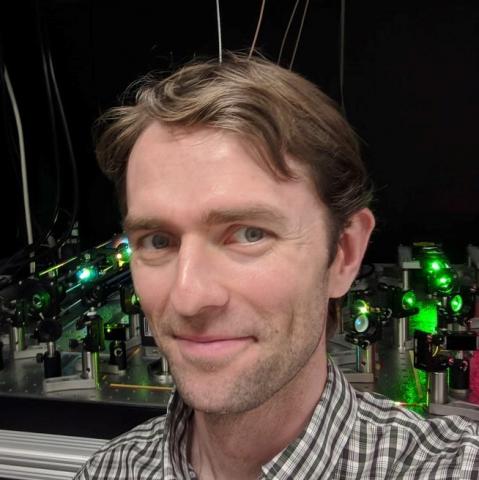Alistair Boettiger, PhD
Assistant Professor of Developmental Biology
Member, Program in Biophysics
Stanford University, School of Medicine
Seminar Information

Gene expression in metazoan animals is controlled by a complex array of regulatory sequence elements, called enhancers, which encode the information for cell-type-specific spatial-temporal patterns of expression needed for development, and which activate transcription from target genes when in spatial proximity. In the past decade, sequencing based methods, such as Hi-C, have uncovered intricate patterns of spatial genome organization which help us understand this complex regulation. However, these methods are largely confined to the analysis of pairwise interactions, leaving many hypotheses about gene-gene competition and multi-way contact hubs unexplored.
In this seminar, I will describe our work using microscopy-based 3D super-resolution chromatin imaging, to investigate aspects of genome folding and transcription regulation inaccessible to Hi-C. I will show how contact-hubs of CTCF-TAD borders facilitate long-range cross-TAD interactions while preserving insulating activities for intervening genes at several key developmental loci. I will then focus on unpublished work on how clusters of enhancers form local “communities” that enhance transcriptional burst frequency and burst size. I will close with an explanation of a next-generation live imaging technique we have developed to push the boundaries of spatial-temporal resolution and follow the rapid dance of genomic sequences in exquisite detail.
Alistair Boettiger is an Assistant Professor of Developmental Biology at Stanford University, where his lab develops and applies quantitative super-resolution microscopy to study the role of 3D genome organization in transcriptional regulation and differentiation. Alistair completed his undergraduate training in the Department of Physics at Princeton University, where Stansilav Shvartsman introduced him to quantitative imaging in Drosophila development. He conducted his Ph.D. research in Biophysics under the guidance of Michael Levine at UC Berkeley, a team known for pioneering work understanding cis-regulation in Drosophila, where his work identified several molecular and genetic mechanisms ensuring transcriptional precision and robustness in early embryogenesis. His postdoctoral research was conducted in the laboratory of Xiaowei Zhuang at Harvard, known for pioneering work in single-molecule super-resolution. There, he co-led the development of methods for image-based spatial transcriptomics with fellow physicist Jeffrey Moffitt and graduate student Kok-Hao Chen, and adapted super-resolution microscopy approaches to uncover organizational principles of how epigenetic differences affect 3D chromatin folding. Since 2016, his team at Stanford combines the power of both Drosophila genetics and mouse embryonic stem cell genetics with single-molecule and super-resolution imaging to better understand transcriptional regulation during development. His awards include recognition as a ”Dale Frey Award for Breakthrough Scientists”, a “New Innovator” from NIH, a “Packard Foundation Fellow”, a “Beckman Young Investigator”, a “Kavli Fellow” from the National Academy of Sciences, and a “Searle Scholar”.
